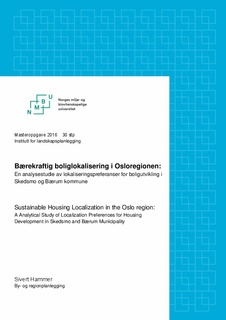| dc.contributor.advisor | Grønning, Marius | |
| dc.contributor.author | Hammer, Sivert | |
| dc.date.accessioned | 2016-08-25T13:35:55Z | |
| dc.date.available | 2016-08-25T13:35:55Z | |
| dc.date.issued | 2016-08-25 | |
| dc.identifier.uri | http://hdl.handle.net/11250/2401836 | |
| dc.description.abstract | Den regionale planen for Oslo og Akershus har satt lys på en av de største utfordringene i norsk planlegging, nemlig den fremtidige utviklingen av Osloregionen. I det nylig vedtatte regionale planforslaget, har det blitt lagt opp til en såkalt flerkjernet byutvikling av regionen, der et par utvalgte byer/tettsteder vil måtte belage seg på å ta en større andel av den fremtidige befolkningsveksten. I den forbindelse har Skedsmo og Bærum kommune blitt utpekt som to av de viktigste områdene for fremtidig bolig- og befolkningsvekst i Akershus. Med utgangspunkt i denne konteksten, har jeg undersøkt i hvilken grad den regionale planen kan bidra til at de kommunale planmyndighetene i Skedsmo og Bærum legger til rette for en mer bærekraftig lokalisering av boliger.
Tilnærmingen til oppgavens hovedproblemstilling har i stor grad basert seg på analyser av Skedsmo og Bærum sin historiske arealbruksutvikling, samt fremtidige planer og strategier i boligutviklingen. Ut i fra analysene har man avdekket hvilke drivkrefter som har vært med på å forme kommunenes utbyggingsmønster, samt hvordan de kommunale planmyndighetene forholder seg til prinsippene om boliglokalisering som målbæres i den regionale planen. Resultatet av det analytiske arbeidet har vist at hverken Skedsmo eller Bærum kommune virker klar for en omstilling til en flerkjernet bystruktur, der Lillestrøm og Sandvika blir forsterket som regionale byer. Således har den regionale planen i mindre grad hatt innvirkning på kommunenes prioriteringer i å legge til rette for en mer bærekraftig lokalisering av boliger. På en annen side har analysene også vist at kommunene gjør valg som bygger oppunder en forsterket vekst i sentraliserte områder med god kollektivdekning, men spredt feltutbygging som bidrar til økt bilbruk er fortsatt til stede i begge kommunene. Det er enda for tidlig å konkludere om den regionale planen vil få en stor innvirkning på de kommunale planmyndighetenes valg i boliglokalisering, da planen nylig har blitt vedtatt. I utgangspunktet er det liten tvil om at den regionale planen vil være et viktig verktøy og initiativ for å legge til rette for en mer bærekraftig lokalisering av boliger i tiden fremover, men bruken av planen som virkemiddel må muligens bli sterkere. Politikernes beslutninger og veivalg er til syvende og sist avgjørende for om Osloregionen skal kunne omstille seg til å bli en bærekraftig og konkurransedyktig hovedstadsregion i Norge. | nb_NO |
| dc.description.abstract | The regional plan for Oslo and Akershus has highlighted one of the biggest challenges in Norwegian planning, namely the future development of the Oslo region. In the recently
adopted regional plan proposal, it has been added up to a polycentric city development of the region, where a few selected cities will have to rely on taking a larger share of the future population growth. In this connection Skedsmo and Bærum municipality has been selected as two of the key areas for future housing and population growth in Akershus. Given this context, I have investigated the extent to which the regional plan can help ensure that the local planning authorities facilitate a more sustainable localization of housing. The approach in this study has mainly been based on analyzes of Skedsmo and Bærum’s historical land use development as well as future plans and strategies in housing developments. Based on the analysis there has been revealed witch forces that have helped to shape the municipalities land use patterns, and how the planning authorities in the municipal has relate to the principles of housing localization contained in the regional plan. The results of the analytical work have shown that neither Skedsmo or Bærum seems ready for a transition to a polycentric structure, where Lillestrøm and Sandvika is amplified as regional cities. Thus, has the regional plan in small extent affected the municipalities priorities to facilitate a more sustainable location of housing. On the other hand analyzes have also shown that the local planning authorities make choices that support a reinforced growth in centralized areas with good public transportation, but scattered field development which contributes to increased car use are still present in both municipalities. It is yet too early to conclude whether the regional plan will have an impact on municipalities choices in housing localization, since the plan recently has been adopted. Basically, there is little doubt that the regional plan will be an important tool and initiatives to create a more sustainable localization of housing in the future, but the use of the plan as an instrument may need to become stronger. Politician’s decisions and choices are ultimately decisive to achieve a sustainable and competitive capital region in Norway. | nb_NO |
| dc.language.iso | nob | nb_NO |
| dc.publisher | Norwegian University of Life Sciences, Ås | |
| dc.subject | Regional planlegging | nb_NO |
| dc.subject | Boligplanlegging | nb_NO |
| dc.subject | Lokaliseringsanalyser | nb_NO |
| dc.subject | Lokal planlegging | nb_NO |
| dc.subject | Bærekraftig utvikling | nb_NO |
| dc.title | Bærekraftig boliglokalisering i Osloregionen : en analysestudie av lokaliseringspreferanser for boligutvikling i Skedsmo og Bærum kommune | nb_NO |
| dc.title.alternative | Sustainable Housing Localization in the Oslo region: An Analytical Study of Localization Preferences for Housing Development in Skedsmo and Bærum Municipality | nb_NO |
| dc.type | Master thesis | nb_NO |
| dc.source.pagenumber | 120 | nb_NO |
| dc.description.localcode | M-BYREG | nb_NO |
